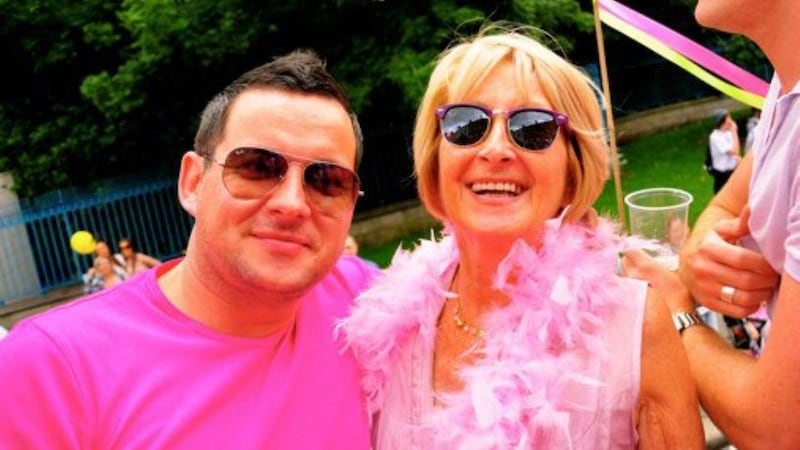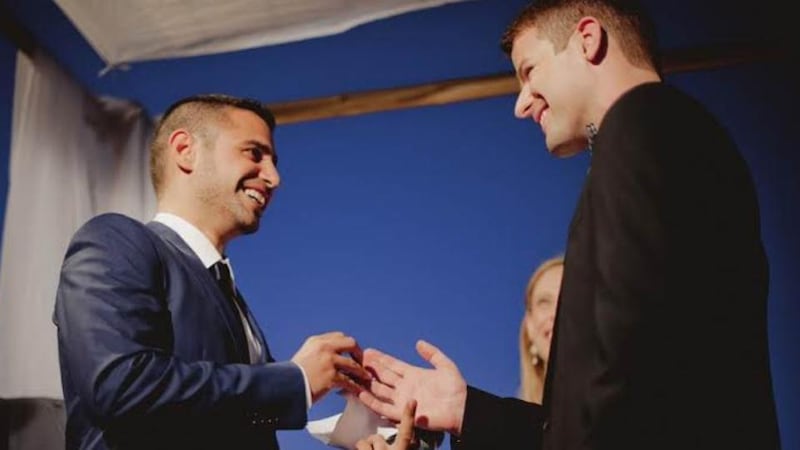It’s 40 years since the first Gay Pride festival in Dublin but it wasn’t always as much fun as this year’s event will be. On June 27th 1974, a gay rights public demo was held outside the Department of Justice (Irish Gay Pride Day), when eight people protested about anti-gay laws. Despite its importance, it wasn’t until March 1979, with the establishment of Ireland’s first ever LGBT community centre, the Hirschfeld Centre, that the human and economic resources became available to mount a proper week of events: Gay Pride Week.
This was organised by the National Lesbian and Gay Federation (NLGF) in June of that year and the highlight of the event was the release of 2,000 pink balloons at St Stephen’s Green.
Twelve months later, in June 1980, the city saw the first really significant Pride week in Ireland, with around 20 lesbians and gay men wandering around Dublin city centre giving out pink carnations (then a symbol of gay liberation), four-page leaflets explaining the origins of the Stonewall riots in the US and asking people to support gay law reform. Week-long events followed the following two years in Dublin which involved all-night discos, public protests and picnics in Merrion Square.


However, it was the brutal murder of a 31-year-old gay man called Declan Flynn in Fairview Park in 1982 that would act as a catalyst for protest, a protest which would grow and later evolve into the celebratory-style LGBT Pride Festival we recognise in the city today.
Officially, the first Dublin pride parade was held in June 1983 (called the Gay Rights Protest March), involving about 200 people from Belfast, Cork, Dublin and elsewhere marching from St Stephen’s Green to the GPO where a rally was addressed by activists Christopher Robson, Tonie Walsh and Joni Crone.
But celebrating with a parade was short-lived. Although week-long Pride events continued to be held throughout the 1980s, the parade itself spluttered to a halt within a few years. According to Tonie Walsh, Curator of the Irish Queer Archive held at the National Library of Ireland “There simply wasn’t the energy and organisation to make it happen. Many people were burnt out, many others had emigrated and we lost so many of our beloved to AIDS,” he says.
It would be another decade before Ireland officially passed legislation which finally decriminalised homosexuality in 1993 and there were no parades between 1985 and 1992, but various events did mark it each year, explains Walsh.
While there has been much progress in Ireland since that first Pride outing, the participants continue to maintain an air of protest. Thousands of lesbian, gay, bisexual and transgender people, not to mention their families and anyone else, regardless of sexuality, will march through Dublin city centre on June 28th celebrating their diversity and strength as a community. The party atmosphere is backed by a strong political agenda as the LGBT community campaign for equal marriage rights and parenting rights.
According to activists such as Max Krzyzanowski, an organiser with LGBT Noise, Dublin has recently seen a spike in the number of homophobic attacks in the city centre, and Pride offers a defiant reminder from the LGBT community that they won’t be kept down by intolerance.
Last year I was lucky enough to attend Tel Aviv Pride. Coming from Ireland, a relatively tolerant society, it was sobering to note that in many Middle Eastern countries gay men and women are still arrested, beaten and even killed for being gay. Many flee their homelands to find relative safety in neighbouring Israel.
Despite Israel wrestling with its own demons, Tel Aviv has become one of the most popular gay destinations on the planet, and was voted Best Gay City in a recent American Airlines/GayCities.com survey, beating New York and London.
Tel Aviv’s fifteenth annual Gay Pride festival was attended by a record breaking 100,000 participants and attracted over 20,000 tourists. including France’s first gay married couple, who were there on honeymoon.
As in Ireland, same-sex couples cannot marry in Israel. In fact, there is no civil marriage there of any kind and all couples (regardless of their sexuality) are expected to marry in religious ceremonies. The Reform and Conservative branches of Judaism do conduct same-sex marriages, although the State only recognises marriages conducted by the Orthodox branch of Judaism, which does not permit same-sex marriage.
However, the Israeli State recognizes same-sex marriages conducted abroad and also gives full rights to de facto same sex relationships. A bill was recently approved, which gave full-inheritance rights to same-sex couples regardless of their marrital status. Same-sex couples also have the right to have children through surrogacy and also full adoption rights.
While in Tel Aviv, I talked with Daragh Lally, an Irish man who moved to Israel from Ireland, to live with his Israeli partner, Lior Nener. They sealed a civil partnership in Dublin in 2013.
“Originally from Roscommon, I moved to Tel Aviv two years ago, to live with my Israeli partner. Prior to that, I lived in Dublin for 10 years.
“It’s a complex place, but I like living here. The Irish have a lot in common with the Israelis – each have a history of oppression, both have globally scattered diasporas, both have a self-deprecating sense of humour,” he says.
Possibly the biggest difference between Israel and Ireland, in terms of society and same-sex relationships, is around the family, he says. “People here generally assume that if you’re a couple, whether straight or gay, that you’re going to have kids. In my experience in Ireland,” according to Daragh, “people don’t make this automatic assumption with same-sex couples.
“Tel Aviv is a relaxed, cosmopolitan place, so another difference is that it’s a major attraction for gay tourists from around the world. The Mediterranean beaches and the weather play a part in that too of course,” he says.
As it does in Dublin, the Pride party in Tel Aviv rages on into the early hours, and while everyone is united in pride, everyone is also united in a shared history, a shared struggle and a shared desire to live in a tolerant and equal society.
When Panti Bliss (Rory O’Neill, drag performer and gay activist) spoke at Dublin Pride two years ago, she commented about the amazing turn out of so many young people all having a good time in Merrion Square and then asked all the young gays present to get in touch with their history. “When you go home,” she said, “I want you to google Stonewall, I want you to google the Hirschfeld Centre, and I want you to google Declan Flynn. Because if you don’t know where you came from, how can you possibly know where you want to go?”
We are often asked why we feel the need to have our own Pride parade as heterosexuals don’t have their own “Straight Day”, but in our opinion, for the other 364 days of the year they do. Until gay couples can safely walk down the street holding hands with their partners without experiencing threats of violence or name-calling, Pride is an important day. It’s also a celebration and a day when all of the LGBT community can come together and can be proud of who they are and what they have achieved. You shouldn’t have to be proud of being gay but being able to live openly gay is something to take pride in.
Pride Week runs from tomorrow, June 14th until June 29th.
The Dublin Pride Parade will take place on Saturday June 28th. See dublinpride.ie for more
For more on the Irish Queer Archive see facebook.com/IQAadvisorygroup
Tel Aviv Gay Pride Parade is taking place today. See gaytlvguide.com
For further information about Israel, visit thinkisrael.com
(Ian Lambkin is Online Advertising Key Account Executive at The Irish Times)










